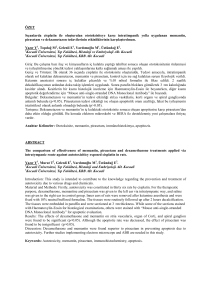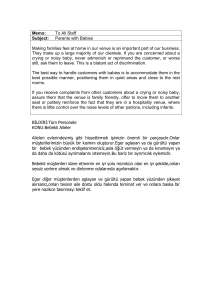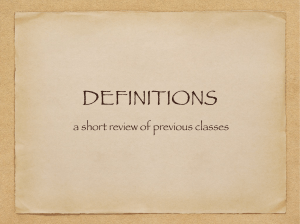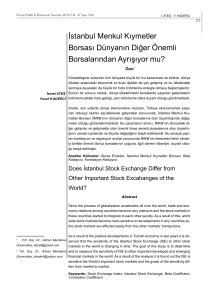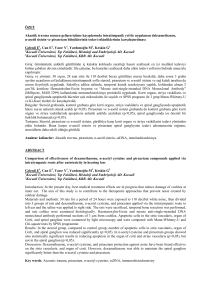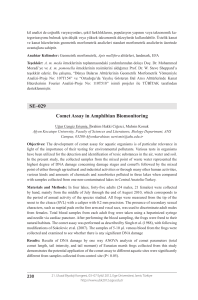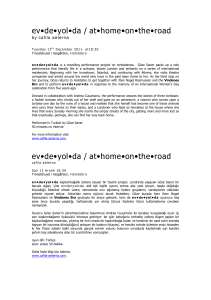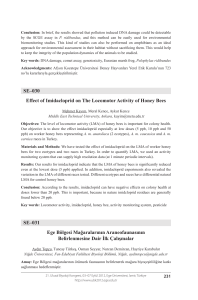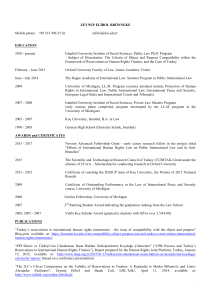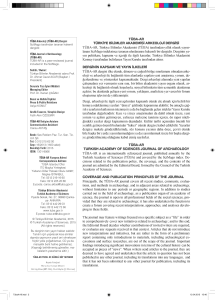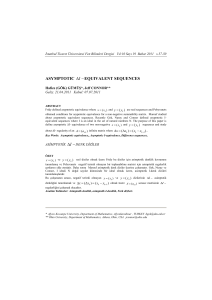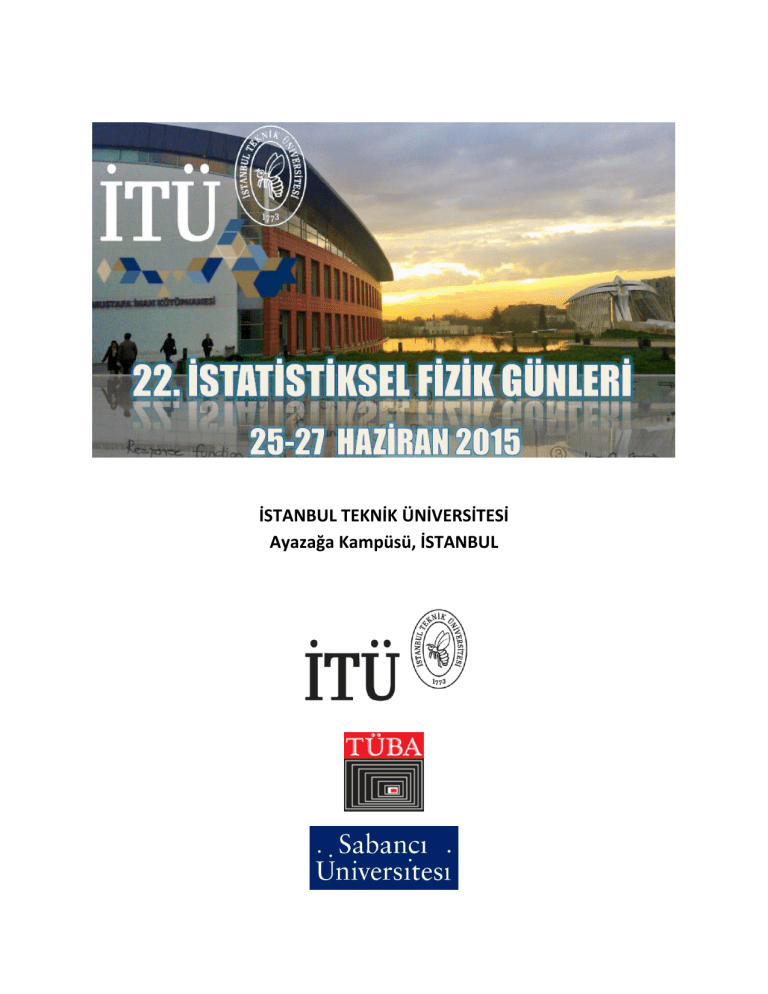
İSTANBUL TEKNİK ÜNİVERSİTESİ
Ayazağa Kampüsü, İSTANBUL
BİLİM KURULU
Prof. Dr.
Zehra AKDENİZ
Piri Reis Üniversitesi
Prof. Dr.
Canan ATILGAN
Sabancı Üniversitesi
Prof. Dr.
Nihat BERKER
Sabancı Üniversitesi
Prof. Dr.
Can Fuat DELALE
Mef Üniversitesi
Prof. Dr.
A. Levent DEMİREL
Koç Üniversitesi
Prof. Dr.
Gülay DERELİ
Koç Üniversitesi
Prof. Dr.
Sondan Durukanoğlu FEYİZ Sabancı Üniversitesi
Doç. Dr.
Zafer GEDİK
Sabancı Üniversitesi
Doç. Dr.
Gül GÜLPINAR
Dokuz Eylül Üniversitesi
Prof. Dr.
Avadis HACINLIYAN
Yeditepe Üniversitesi
Doç. Dr.
Alkan KABAKÇIOĞLU
Koç Üniversitesi
Prof. Dr.
Mustafa KESKİN
Erciyes Üniversitesi
Doç. Dr.
Muhittin MUNGAN
Boğaziçi Üniversitesi
Prof. Dr.
Özgür MÜSTECAPLIOĞLU
Koç Üniversitesi
Doç. Dr.
Sevtap Yıldız ÖZBEK
İstanbul Teknik Üniversitesi
Doç. Dr.
A.Levent SUBAŞI
İstanbul Teknik Üniversitesi
Prof. Dr.
Bilal TANATAR
Bilkent Üniversitesi
Prof. Dr.
Uğur TIRNAKLI
Ege Üniversitesi
Prof. Dr.
Cemal YALABIK
Bilkent Üniversitesi
Prof. Dr.
Ayşe ERZAN
İstanbul Teknik Üniversitesi
Prof. Dr.
Mehmet ERBUDAK
University of Zurih
DANIŞMA KURULU
2
DÜZENLEME KOMİTESİ
Doç. Dr.
Sevtap Yıldız Özbek
İstanbul Teknik Üniversitesi
Doç. Dr.
Ahmet Levent Subaşı
İstanbul Teknik Üniversitesi
Araş. Gör
Mehmet Can Çetinkaya
İstanbul Teknik Üniversitesi
Şenay Üstünel
İstanbul Teknik Üniversitesi
Seda Kol
İstanbul Teknik Üniversitesi
Sevtap Yıldız Özbek
İstanbul Teknik Üniversitesi
PROGRAM YÜRÜTÜCÜSÜ
Doç. Dr.
DESTEKLEYEN KURULUŞLAR
İSTANBUL TEKNİK ÜNİVERSİTESİ
TÜBA – Türkiye Bilimler Akademisi
SABANCI ÜNİVERSİTESİ
3
22. İSTATİKSEL FİZİK GÜNLERİ 25-27 HAZİRAN 2015
İSTANBUL TEKNİK ÜNİVERSİTESİ
Ayazağa Kampüsü
Elektrik Elektronik Fakültesi – İdris Yamantürk Konferans Salonu
PROGRAM
25 HAZİRAN PERŞEMBE
08:30-09:00 Karşılama ve Kayıt
09:00-10:00 Anna Minguzzi (Université Grenoble-Alpes and CNRS)
‘’Persistent current flows and macroscopic superpositions of current states for
interacting bosons on a ring with a gauge field’’
10:00-10:30 Tonguç Rador (Boğaziçi Üniversitesi)
‘’2 Agent games on Graphs’’
10:30-10:50 Ara
10:50-11:20 Miguel Navascues (Bilkent Universitesi)
‘’Non-thermal operations as a quantum thermodynamical resource’’
11:20-11:50 R.Onur Umucalılar (Koç Universitesi)
‘’Artificial magnetic field effects in photonic systems’’
11:50 – 12:50 Kısa Konuşmalar (A1 – A6)
12:50-14:00 Öğle Yemeği
14:00-14.30 Öznur Taştan (Bilkent Üniversitesi)
‘’ Active Learning by Statistical Leverage Samplingi’’
14:30 – 16:10 Kısa Konuşmalar (B1 – B10)
4
26 HAZİRAN CUMA
09:00-10:00 Anna Minguzzi (Université Grenoble-Alpes and CNRS)
‘’Excitons-polaritons : properties of an out-of-equilibrium quantum gas’’
10:00-10:30 Cem Celebi (İzmir Yüksek Teknoloji Üniversitesi)
‘’Epitaxial Graphene Transparent Electrode for Silicon Carbide Based Ultraviolet
Photodetector’’
10:30-10:50 Ara
10:50-11:20 Deniz Eroglu (Humboldt University)
‘’Connectivity-Driven Coherence of Heterogeneous Oscillators on Complex Networks’’
11:20-11:50 Cetin Kılıc (Gebze Teknik Üniversitesi)
‘’ Computational studies of doped ZnO nanowires’’
11:50 – 12:50 Kısa Konuşmalar (C1 – C6)
12:50-14:00 Öğle Yemeği
14:00-14:30 Aslı Tuncer (Istanbul Teknik Üniversitesi)
‘’Spectral Renormalization Group and Critical Exponents on Cayley and Diamond
Lattices’’
14:30-15:00 Ethem Aktürk (Adnan Menderes Üniversitesi)
‘’The Hallmark of Two and One dimensional Hexagonal Structures’’
15:00 – 16:00 Kısa Konuşmalar (D1 – D6)
16:00-16:30 Mine Konuk (Piri Reis Üniversitesi)
‘’ Molecular and Atomic Mechanisms on Metal Nanostructures’’
16:30-17:00 Efe İlker (Sabancı Üniversitesi)
‘’ Controlling Frustration, Chaos, and Novel Ordering in Spin-Glasses’’
5
27 HAZİRAN CUMARTESİ
09:30-10:00 Umut Gursoy (Utrecht University)
‘’(Non)-renormalization of anomalous conductivities and holography’’
OTURUMLAR
10:00-11:00 Prof. Dr. Nazmi Postacıoğlu
11:00-12:00 Doç. Dr. M. Sinan Özeren
6
KISA KONUŞMA OTURUMLARI – Yazarlar (Konuşmacı) ve Başlıklar
A Oturumu- 25 Haziran Perşembe (11:50 – 12:50)
A1.
Sofia Piepoli (Sabancı Üniversitesi) , Batu Erman, Canan Atılgan
“Analysis on Target specific Transcription Activator-like Effectors by Free
Energy Perturbation Calculations and Perturbation-Response Scanning”
A2.
Uğur Tırnaklı (Ege Üniversitesi), Ernesto P. Borges
“Düşük-boyutlu korunumlu mapler: Boltzmann-Gibbs istatistiğinden Tsallis
istatistiğine”
A3.
Selcuk Cakmak (On Dokuz Mayıs Üniversitesi),Ozgur E.
Mustecaplioglu
“Investigation of Lipkin-Meshkov-Glick Model As a Working Substance In
Quantum Otto Cycle”
A4.
Sibel Gökçe (Celal Bayar Üniversitesi)
“Study on bi-directional pedestrian movement using ant algorithm”
A5.
Gülşen Akın Evingür (Piri Reis Üniversitesi), Hakan Kaygusuz, F.
Bedia Erim, Önder Pekcan
“Slow Release Kinetics of Alginate Beads”
A6.
Gökhan Bilir (İstanbul Teknik Üniversitesi), Gönül Eryürek
“Doped and Un-doped Metal Oxide Nano-powders as a Source of
Incandescent Lamp-like Emission”
7
B Oturumu 25 Haziran Perşembe (14:30 – 16:10)
B1.
Buğra Tüzemen (İstanbul Teknik Üniversitesi)
“Spin Momentum Bağlı Fermiyon Sistemlerinde Richardson Modeli'nin
Uygulanması”
B2.
Enes Doko (Koç Üniversitesi)
“Dönen iki boyutlu spin-orbit bağlı fermi gazlar”
B3.
Can F. Delale (MEF Üniversitesi), Şenay Pasinlioğlu
“Reduced Order Gas Pressure Law for the Thermal Behaviour of Gas
Bubbles”
B4.
Ayşe Ferhan Yeşil (Bilkent Üniversitesi), M. Cemal Yalabik
“Analysis of resonance-like response of a memoryless system under periodic
boundary conditions”
B5.
Bilal Tanatar (Bilkent Üniversitesi), V. Moldoveanu, I. V. Dinu
“Tek-Molekül Mıknatıslarında Zamana Bağlı Taşınım”
B6.
Gökhan Şahin (Yeditepe Üniversitesi)
“Derlem Dışı Parametrizasyon ile Dillerde ki Uzun Dönemli Korelasyonların
Bulunması”
B7.
Tolga Kostak , Can Ertugay , Aslı Gençaslan, M. Özgür Güler , Deniz
Kaya (Akdeniz Üniversitesi)
“Video Mikroskop ve Koloit Parçacıklar kullanılarak Yumuşak Maddelerin
Mikro-Reolojik Özelliklerinin Ölçülmesi”
B8.
Haled Abdizadeh (Sabancı Üniversitesi)
“Detailed Molecular Dynamics Simulations of Human Transferrin Provide
Insights on Iron Release Dynamics at Serum and Endosomal pH”
B9.
Engin Kandiran (Yeditepe Üniversitesi), Avadis Hacinliyan
“Smoothing discontinuities in Predator Prey Models”
B10.
Birses Debir (Boğaziçi Üniversitesi)
“BEC in curved backround”
8
C Oturumu 26 Haziran Cuma (11:50 – 12:50)
C1.Efe Ilker (Sabancı Üniversitesi), Sondan Durukanoğlu
“Growth Modes of Nano Size Cu-Ni alloys”
C2.Deniz Türkpençe (Koç Üniversitesi)
“Thermodynamic properties of photonic quantum engines”
C3.Fatma Nur Ünal (Bilkent Üniversitesi)
“Impurity coupled to an artificial magnetic field in a Fermi gas in a ring
trap”
C4.Numan Şarlı (Erciyes Üniversitesi)
“The end of the paramagnetism at Tan”
C5.İskender Yalçınkaya (Sabancı Üniversitesi), Zafer Gedik
“Kesikli zaman kuantum yürüyüşleri ile kubit hali aktarımı”
C6.Ahmet Çelikoğlu (Ege Üniversitesi), Uğur Tırnaklı
“Gaussiyen olmayan dağılımlar için çarpıklık ve basıklık analizi”
9
D Oturumu 26 Haziran Cuma (15:00 – 16:00)
D1.
Kıvanç Çetin (Ege Üniversitesi), Özgür Afşar, Uğur Tırnaklı
“Düşük-Boyutlu Dinamik Sistemlerin Kaos Geçiş Eşiği Civarında Davranışları
ve Bunların Sağlamlık Analizi”
D2.
Gizem Özbaykal (Sabancı Üniversitesi), Canan Atılgan, and Ali Rana
Atılgan
“Motifs resolve how random the protein structures are”
D3.
Gökşin Liu (Sabancı Üniversitesi), Eren Yalçın, Ali Rana Atılgan, Canan
Atılgan, Ali Koşar, Alpay Taralp
“Monitoring iron release/binding mechanism with a microfluidic stopped
flow device”
D4.
Batuhan Kav (Koç Üniversitesi), Murat Öztürk, Alkan Kabakçıoğlu
“GR Protein Ailesinde Gerçekleşen İşlev Değiştiren Mutasyonlar ve Mod
Etkileşimindeki Rolleri”
D5.
Ibrahim Ozken (Ege Üniversitesi), Deniz Eroglu, Thomas Stemler,
Norbert Marwan, Baris Bagci, and Jürgen Kurths
“Eşit Zaman Aralığına Sahip Olmayan Verilerin Analizi için Dönüşüm Maliyet
Zaman Serisi (Transformation Cost Time Series - TACTS) Yöntemi”
D6.
Ceren B. Dağ (Istanbul Teknik Üniversitesi), A. Levent Subaşı, Özgür
E. Müstecaplıoğlu
“Tek modlu oyukların 3-atomlu rezervuarlarla termalleşmesi”
10
KONUŞMA ÖZETLERİ
11
Persistent current flows and macroscopic superpositions of current states for
interacting bosons on a ring with a gauge field
A. Minguzzi
E-mail: [email protected]
We study interacting one-dimensional bosons on a ring lattice, subjected to a rotating
barrier potential, which induces an artificial U(1) gauge field and a persistent current
flow on the ring. We show that, at intermediate interactions, the persistent current
response is maximal, due to a subtle interplay of effects due to the barrier, interactions
and quantum fluctuations [1]. We then study how the persistent current amplitude
scales with system size finding that the also scaling is optimal, i.e. the current amplitude
decreases slower with the system size at intermediate interactions [2]. Finally, we study
the gap and the visibility of the macroscopic superposition state of current states
realized with this setup. We find that a mesoscopic ring lattice with intermediate-tostrong interactions and weak barrier depth is a favourable candidate for setting up,
manipulating and probing a qubit in the next generation of experiments with ultracold
atoms [3].
References
[1] M. Cominotti, D. Rossini, M. Rizzi, F.W.J. Hekking and A. Minguzzi, Phys. Rev.
Lett. 113, 025301 (2014)
[2] M. Cominotti, D. Rossini, M. Rizzi, D. Aghamalayan, L. Amico, L.-C. Kwek, F.W.J.
Hekking and A. Minguzzi, arXiv:1409.1835
[3] D. Aghamalyan, M. Cominotti, M. Rizzi, D. Rossini, F.W.J. Hekking, A. Minguzzi,
L.-C. Kwek and L. Amico, arXiv:1411.4812
12
2 Agent games on Graphs
Tonguc Rador
Let us assign agent on the nodes of a graph and endow them with integerpoints. Now
let us randomly pick an edge on the graph, thisunambiguously defines two agents with
points say L and S. We increasethe point of one and only one of them as follows: If L>S
we have (L,S)to (L+1,S) with probability p, if L<S we have (L,S) to (L,S+1) withprobability
q=1-p, and if L=S only one receives the point equallylikely.We study the infinite time
behavior of the point distribution -providedan initial condition is given- on various
graphs. The model can bemapped to a type of altered coloring model on regular graphs
whereason irregular graphs there are also various interesting aspects dependingon the
local geometry of the graph.In particular we study the model on n-dimensional tori and
find criticalbehavior in n=2.
13
Non-thermal operations as a quantum thermodynamical resource
Miguel Navascues
Quantum thermodynamics studies the emergence of thermodynamical laws inquantum
microscopic systems. An important input from quantum informationscience has been to
reformulate quantum thermodynamics as a resourcetheory, whereby thermal states are
free and the only allowed operationsare unitary transformations commuting with the
total Hamiltonian of thesystem. This approach to quantum thermodynamics has allowed
us, forinstance, to re-interpret quantum free energy as the asymptotic conversion
rate between different states, or the amount of work which can beextracted on average
out of a resource quantum state. Previous literatureon quantum thermodynamics has
just focused on transformations betweendifferent state resources, forgetting that
quantum operations which do notcommute with the total energy also constitute a nonfree resource. In thiswork, given a number of non-thermal quantum channels, we study
the problemof how to integrate them in a thermal engine so as to generate the
maximum
amount of work W_max. We find that W_max is an additive function of theconsidered
channels, computable for both finite dimensional quantumoperations and bosonic
channels. We apply these insights to bound theamount of extractable work due to the
natural non-thermal processespostulated in the Ghirardi-Rimini-Weber (GRW) theory.
We find that,although GRW theory (and, for the matter, any proposed collapse model)
predicts the possibility to extract work from the vacuum at no cost, inthe best of the
cases the rate of extraction would be ridiculously low.
14
Artificial magnetic field effects in photonic systems
R. O. Umucalılar
Department of Physics, Koç University, Rumelifeneri Yolu, 34450 Sarıyer, İstanbul, Turkey
In this talk, I will present some of the outcomes of my theoretical work on photonic
systems experiencing an artificial magnetic field. After a brief introduction to quantum
fluids of light where the quasiparticles of light-matter interaction, namely polaritons,
behave collectively in a nonequilibrium setting, I will continue with the problem of
simulating a magnetic field for photons (and polaritons) which are neutral particles. I
will discuss various phenomena predicted to appear in these systems ranging from the
integer quantum Hall effect in a coupled cavity array to the nonequilibrium fractional
quantum Hall physics where photons can be driven into strongly-correlated states
resembling the Laughlin state in the presence of strong optical nonlinearity.
15
Active Learning by Statistical Leverage Sampling
Oznur Tastan
Active learning aims to obtain a classifier of high accuracy by using fewer label requests
in comparison to passive learning by selecting effective queries. Many active learning
methods have been developed in the past two decades, which sample queries based on
informativeness or representativeness of unlabeled data points. In this work, we explore
a novel querying criterion based on statistical leverage scores. The statistical leverage
scores of a row in a matrix are the squared row-norms of the matrix containing its (top)
left singular vectors and is a measure of influence of the row on the matrix. Leverage
scores have been used for detecting high influential points in regression diagnostics and
have been recently shown to be useful for data analysis and randomized low-rank
matrix approximation algorithms. We explore how sampling data instances with high
statistical leverage scores perform in active learning. Our empirical comparison on
several binary classification datasets indicate that querying high leverage points is an
effective strategy.
This is joint work with Cem Orhan, (Bilkent University, Department of Computer
Engineering)
16
Excitons-polaritons : properties of an out-of-equilibrium quantum gas
A. Minguzzi
Laboratoire de Physique et Modélisation des Milieux Condensés, Université GrenobleAlpes and CNRS, Grenoble, France
E-mail: [email protected]
Exciton polaritons are out-of-equilibrium quantum fluids, obtained under drivendissipative conditions in reduced dimensionality (quasi-one-dimension, two-dimension).
The first-order correlation function is accessible experimentally *1+. I will present first a
mean-field model which allows to take into account both the driven-dissipative nature of
the fluid and the effect of a smooth disorder, yielding a very good agreement with the
experiment *1+. Then, I will use a quantum Langevin approach combined with a
Luttinger-liquid description of the fluid to determine the large-distance behaviour of
the first-order correlation function at arbitrary interaction strength in the clean case,
showing how beyond-mean-field interactions yield a reduction of coherence at large
distances *2+. Finally, I will present an application of the out-of-equilibrium polariton gas
as refrigerant, capable of absorbing low-energy phonons in a solid *3+.
References
[4]
Aurélien Trichet, Emilien Durupt, François Médard, Sanjoy Datta, Anna
Minguzzi, Maxime Richard, Phys. Rev. B 88, 121407(R) (2013)
[5]
S. Datta, M. Wouters and A. Minguzzi, in preparation
[6]
Sebastian Klembt, Emilien Durupt, Sanjoy Datta,Thorsten Klein, Augustin Baas,
Yoan Léger, Carsten Kruse, Detlef Hommel, Anna Minguzzi, and Maxime Richard,
in preparation
17
Epitaxial Graphene Transparent Electrode for Silicon Carbide Based
Ultraviolet Photodetector
Cem Çelebi
İzmir Institute of Technology, Department of Physics, Nanophysics Research Group
35430 Urla / İzmir
Graphene is considered to be used as transparent conductive electrode for next
generation photodetectors and solar cells due to its excellent optical transparency, high
electrical conductivity and mechanical flexibility. During the last decade, conventional
transparent conductors out of Ni/Au, Ti, Ti/W, and ITO have been widely employed to
collect photo-generated charge carriers in those optoelectronic and photovoltaic
devices. However, most of these materials inherently have very low optical
transmittance (< 80%) especially in the ultraviolet (UV) regime below 400 nm due to
high surface reflection and absorption. Unlike those above mentioned contact materials,
graphene is capable of transmitting more than 90% of light in the wavelength range
between 200 and 400 nm. As a consequence of its relatively high UV transmission level
and zero band gap, graphene has become a promising candidate as transparent and
conductive electrode for UV sensitive photodetectors.
In my talk, I will present our preliminary experimental results on the fabrication and
characterization of graphene-semiconductor-graphene (GSG) ultraviolet photodetector
based on the rectifying character of Schottky junction at the interface between epitaxial
graphene and Silicon Carbide SiC semiconductor. As-grown single layer epitaxial
graphene is interdigitated as transparent conductive electrode to probe photogenerated charge carriers in a semi-insulating 4H-SiC substrate. The fabricated device
exhibits the typical current-voltage characteristics of a conventional metalsemiconductor-metal type photodetector with low leakage current. Our measurements
based on time-resolved photocurrent measurements suggest an excellent photocurrent
reversibility and high response speed of the device. The measurements performed for
different illumination wavelengths showed that the sample reveals higher responsivity
values when it is exposed to the light with 254 nm wavelength. The obtained results
imply that epitaxial graphene can be used readily as transparent conductor for SiC based
optoelectronic device applications.
18
Connectivity-Driven Coherence of Heterogeneous Oscillators on Complex
Networks
Deniz Eroglu
1,2
, T. Pereira3, G. B. Bagci4, U. Tirnakli4, and H.J. Jensen3
1
Potsdam Institute for Climate Impact Research (PIK), 14473 Potsdam, Germany
2
Department of Physics, Humboldt University, 12489 Berlin, Germany
3
Department of Mathematics, Imperial College London, South Kensington Campus,
London SW7 2AZ, UK
4
Department of Physics, Faculty of Science, Ege University, 35100 Izmir, Turkey
October 20, 2014
In the nature, there is a tendency towards to collective motion. Collective behaviour of
coupled elements is one of the observed and proved phenomena on dynamical systems.
Moreover, we see this behaviour on different structures of connected elements which are
named complex networks. During the past decades, our understanding of collective behaviour
on complex networks has increased significantly. So far, in general, researchers have focused on
synchronization of coupled periodic elements with different frequencies such as Kuramoto
model [1, 2] or identical periodic/chaotic oscillators [3, 4] via interaction akin to diffusion.
We study the emergence of coherence in complex networks of mutually coupled
nonidentical ele-ments [5]. We uncover the precise dependence of the dynamical coherence on
the network connectivity, the isolated dynamics of the elements, and the coupling function.
These findings predict that in random graphs the enhancement of coherence is proportional to
the mean degree. In locally connected networks, coherence is no longer controlled by the mean
degree but rather by how the mean degree scales with the network size. In these networks,
even when the coherence is absent, adding a fraction s of random con-nections leads to an
enhancement of coherence proportional to s. Our results provide a way to control the
emergent properties by the manipulation of the dynamics of the elements and the network
connectivity.
References
[1]
[2]
[3]
[4]
[5]
K. Wiesenfeld, P. Colet, and S.H. Strogatz„ Phys. Rev. Lett. 76, 404 (1996).
S. H. Strogatz, Physica (Amsterdam) 143D, 1 (2000).
M. Barahona and L. Pecora, Phys. Rev. Lett. 89, 054101 (2002).
C. W. Wu, Phys. Lett. A 319, 495 (2003).
T. Pereira, D. Eroglu, G.B. Bagci, U. Tirnakli and H.J. Jensen, Phys. Rev. Lett. 110, 234103 (2013)
19
Computational studies of doped ZnO nanowires
Çetin Kılıç
Department of Physics, Gebze Technical University, Gebze, Kocaeli 41400, Turkey
At the beginning of this century, the technological interest has been shifted from bulk ZnO,
which is one of the most studied semiconductors in the second half of the last century[1], to ZnO
nanorods, nanowires and other nanostructures, especially in terms of sensors and optoelectronic
applications[2,3]. Some recent studies have shown that the doping characteristics of ZnO nanowires
could be qualitatively different in comparison to bulk samples[4], which might prove advantageous for
the applications in semiconductor devices. On the other hand, first-principles calculations have
increasingly been used to gain microscopic understanding of the semiconductor doping. Thus, this
presentation concerns itself with a variety of properties of doped ZnO nanowires studied by means of
computational modeling within the framework of the density functional theory. It will be demonstrated
that the latter enables one to compare various (bulk or surface) doping configurations in regard to
structure and stability, and to perform characterization of their electronic levels. It will be articulated
that surface doping ultrathin nanowires with a heavy non-magnetic element such as bismuth might lead
to the spin-orbit induced effects as well as the spin-dependent modification of the band structure where
exchange and/or Rashba-type splitting could occur depending on a particular configuration.
[1] e.g., Ü.Özgür et al., J. Appl. Phys. 98, 041301 (2005).
[2] C. Klingshirn et al., Superlattices and Microstructures 38, 209 (2005).
[3] J. Gomez and O. Tigli, J. Mater. Sci. 48, 612 (2013).
[4] e.g., J. S. Lee et al., Adv. Mater. 23, 4183 (2011).
Acknowledgements
Part of this presentation is based on the results of calculations performed by Mehmet Aras and Dr. Sümeyra
Güler-Kılıç. This work is supported by TÜBİTAK under Grant No. 114F155.
20
Spectral Renormalization Group and Critical Exponents on Cayley and
Diamond Lattices
Aslı Tuncer and Ayşe Erzan
Department of Physics, Istanbul Technical University, Maslak 34469, Istanbul, Turkey
(Dated: December 14, 2014)
In a previous paper, we proposed a spectral renormalization group scheme as a general
approach to the study of fluctuations on arbitrary networks. [1] This approach is modeled on
the “field theoretic” renormalization group a là Wilson [2, 3]. In the spectral renormalization
group approach, the fluctuations of the order parameter are expanded in terms of the
eigenvectors of the graph Laplacian[4], on arbitrary undirected networks. Elimination of the
large eigenvalue fluctuations and rescaling of the effective hamiltonian are expected to yield,
in the same spirit as in the Wilson renormalization group, the rescaling factors for the coupling
constants, which can then be related to the critical exponents.
We implemented the spectral renormalization group theory for the Gaussian model [5–7]
on two deterministic networks, namely the Cayley tree and the diamond lattice [9] as well as
the square and cubic periodic lattices. [8]. The nearest neighbor interaction is diagonalized by
using the eigenvectors of the graph Laplacian, giving rise to a Gaussian theory for continuous
fields. The scaling dimensions of the fields and of the “mass” term are determined
numerically as well as analytically, in terms of β, the scaling exponent of the spectral density
for small eigenvalues.
We compute the specific heat and magnetic field exponents, α and δ, defined respectively as ch
∼ t−α, and h ∼ mδ on the critical isotherm; t = (T − Tc)/Tc is the reduced temperature and m
the magnetization per spin. We obtain theGaussian model values, which go over to the mean
field results if one heuristically takes into account the dangerousirrelevant fourth order term in
the Landau expansion [7].We have since then extended our results to ψ4 theory, which, on
periodic lattices, exhibits critical behavior in the same universality class as the Ising model.
The ψ4 interaction terms are treated perturbatively, using the usual Feynman graph
expansion [2, 3, 7]. We find, as in the Euclidean case, that to first order in the ψ4 coupling
21
constant, the Gaussian fixed point is stable. Higher order calculations are possible using a
perturbation expansion in both thecoupling constant and βc − β = s, where βc = 1.On the
Cayley tree, which has an effective graph spectral dimension d˜ = 2 (or β ≡ (d˜/2) − 1 = 0), we
find thatthe second order calculation does not yield a non-Gaussian fixed point, as should
indeed be expected for the Isingmodel on a Bethe lattice. Explicit solutions for the
eigenvectors of the graph Laplacian involve much reduced cyclic and acyclic permutation
symmetries, in comparison to the much larger translational and rotational symmetry present in
the case of periodic latices. The coupling term that is fourth order in the fields does not scale
with a power of s, leading to the stability of the Gaussian fixed point at second order.We have
also applied the spectral renormalization group to a scalar ψ4 model on the diamond lattice,
which we have found numerically to have a spectral dimension of d˜ = 1.70. However, here
again we found no non-Gaussian fixed point of the RG transformations up to second order, due
to the same mechanism. This, however is problematic, since it is known that the Ising model
on the diamond lattice exhibits a phase transition with ergodicity breaking at a finite
temperature in the thermodynamic limit [11], with non-classical exponents [9]. The diamond
lattice, as well as its Laplace eigenvectors have a further reduced symmetry consisting of just
the “right/left” and “up/down” permutations [10], which apparently leads to this result. This
may imply that the correct critical behavior on lattices without translational symmetry are not
accessible within a perturbative approach via the spectral RG.
[1] E. Aygün, A. Erzan, J. Phys. Conf. Ser. 319, 012007 (2011).
[2] KG Wilson, Phys. Rev. (1971)
[3] K.G. Wilson and J. Kogut J Phys. Rep. 83, 75 (1974)
[4] F.R.K. Chung, Spectral graph theory, (American Mathematical Society, Washington
DC, 1997) [5] T.H. Berlin and M. Kac, Phys. Rev.86, 821 (1952).
[6] K. Huang, Statistical Mechanics (John Wiley and Sons, N.Y., 1987)
[7] N. Goldenfeld, Lectures on phase transitions and the renormalization group (Perseus Books, Reading Mass.,
1992)
[8] A. Tuncer and A. Erzan, “Spectral Renormalization Group and Critical Exponents on Cayley and Diamond
Lattices,” arXiv:1312.2885.
[9] A.N. Berker and S. Ostlund, J. Phys. C 12, 4961 1979.
[10] R.B. Griffiths and M. Kaufman, Phys. Rev. B 26, 5022 (1982).
[11] Bleher, P.M., Zalys, E., Commun. Math. Phys. 67, 17-42 (1979)
22
The Hallmark of Two and One dimensional Hexagonal Structures
Ethem Aktürk
The synthesis of a single atomic layer of graphite, i.e. graphene, with covalently bonded
honeycomb lattice in 2004 has been a breakthrough in basic and applied science. Two
dimensional honeycomb structures derived from other Group IV elements and Group IIIV compounds are generating significant current interest because of unusual electronic
and magnetic properties. Based recent studies published, the properties of silicene, hBN, h-MoS2 appear to be complementary to graphene and hence provide new physical
and chemical properties. Therefore, the main object of my talk is to present exceptional
electronic properties of two dimensional hexagonal structures. To understand how
these properties are affected by adatoms and defects, the effects of foreign atoms and
vacancies on the electronic structure will be also discussed. We found that adatoms and
defects can induce important changes in the electronic and magnetic properties of two
dimensional structures. For example, the semimetallic graphene with carriers behaving
as massless Dirac fermions can be metallized as a result of adsorption of Li or Ca atoms
and hence Li or Ca covered graphene can serve as a high-capacity hydrogen storage
medium with each adsorbed Li or Ca absorbing up to four hydrogen molecules.
Functionalization of two dimensional structures through adatom adsorption and
vacancy creation appears to be a promising way to extend the application of monolayer
hexagonal structures.
23
Molecular and Atomic Mechanisms on Metal Nanostructures
Mine Konuka,b, Sondan Durukanoğluc, d
a
Department of Physics, Istanbul Technical University, 34469 Istanbul, Turkey
b
Department of Physics, Pîrî Reis University, 34940 Istanbul, Turkey
c
Faculty of Engineering and Natural Sciences, Sabancı University, 34950 Istanbul, Turkey
d
Nanotechnology Research and Application Center, Sabancı University, 34950 Istanbul, Turkey
We investigated the mechanisms underlying the controlled motion of adatoms and
molecules on metal surfaces at atomic scale. The role of reaction conditions in the
growth of cubic Ag nano-clusters is determined using molecular dynamic simulations
based on the potential extracted from the embedded atom method. In the simulations,
we successfully reproduced the experimentally observed growth modes and our results
interestingly show that the growth modes of Ag nano-cubes can readily be controlled
through fine-tuning of diffusion rates with respect to the single atom mobility on the
respective facets. We performed further simulations to understand the nature of the
atomic-scale motions of molecular motors on metal surfaces using density functional
theory calculations and also molecular static calculations based on the charge optimized
many body potential. We will discuss atomistic nature of the observed translational and
rotational motion of triptycene molecules (C20H14) on Cu surface.
24
Controlling Frustration, Chaos, and Novel Ordering in Spin-Glasses
Efe Ilker, Sabancı University, Tuzla, Istanbul 34956 Turkey
Spin-glass phases and phase transitions for q-state clock models and their q→∞ limit the XY model, in
spatial dimension d= 3, are studied by a detailed renormalization-group study that is exact for the d = 3
hierarchical lattice and approximate for the cubic lattice. For even q [1], in addition to the now well
established chaotic rescaling behavior of the spin-glass phase, each of the two types of spin-glass phase
boundaries displays, under renormalization-group trajectories, their own distinctive chaotic behavior.
These chaotic renormalization-group trajectories subdivide into two categories, namely as strong
coupling chaos (in the spin-glass phase and, distinctly, on the spinglass–ferromagnetic phase boundary)
and as intermediate-coupling chaos (on the spin-glass–paramagnetic phase boundary). We thus
characterize each different phase and phase boundary exhibiting chaos by its distinct Lyapunov
exponent, which we calculate. We show that, under renormalization group, chaotic trajectories and
fixed distributions are mechanistically and quantitatively equivalent. The phase diagrams for arbitrary
even q, for all non-infinite q, have a finite-temperature spin-glass phase. Furthermore, the spin-glass
phases exhibit a universal ordering behavior, independent of q. The spin-glass phases and the spinglass–paramagnetic phase boundaries exhibit universal fixed distributions, chaotic trajectories and
Lyapunov exponents. In the XY model limit, our calculations indicate a zero-temperature spin-glass
phase. Very distinctive orderings and phase diagram structures are found for odd q.[3] These models
exhibit asymmetric phase diagrams, as is also the case for quantum Heisenberg spin-glass models. No
finite-temperature spin-glass phase occurs. For all odd q > 5, algebraically ordered antiferromagnetic
phases occur. One such phase is dominant and occurs for all q > 5. Other such phases occupy small lowtemperature portions of the phase diagrams and occur for 5 ≤ q ≤ 15. All algebraically ordered phases
have the same structure, determined by an attractive finite-temperature sink fixed point where a
dominant and a subdominant pair states have the only non-zero Boltzmann weights. The phase
transition critical exponents quickly saturate to the high q value. Furthermore, we realized that in spinglass systems, frustration can be adjusted continuously and considerably,[2] without changing the
antiferromagnetic bond probability p, by using locally correlated quenched randomness, as we
demonstrate on hypercubic lattices and hierarchical lattices. Such overfrustrated and underfrustrated
Ising systems on hierarchical lattices in d = 3 and 2 are studied. With the removal of just 51% of
frustration, a spin-glass phase occurs in d = 2. With the addition of just 33% frustration, the spin-glass
phase disappears in d = 3. Sequences of 18 different phase diagrams for different levels of frustration
25
are calculated in both dimensions. In general, frustration lowers the spin glass ordering temperature. At
low temperatures, increased frustration favors the spin-glass phase (before it disappears) over the
ferromagnetic phase and symmetrically the antiferromagnetic phase. When any amount, including
infinitesimal, frustration is introduced, the chaotic rescaling of local interactions occurs in the spin-glass
phase. Chaos increases with increasing frustration, as can be seen from the increased positive value of
the calculated Lyapunov exponent λ, starting from λ = 0 when frustration is absent. The calculated
runaway exponent y_R of the renormalization-group flows decreases with increasing frustration to y_R =
0 when the spin-glass phase disappears. From our calculations of entropy and specific-heat curves in d =
3, it is shown that frustration lowers in temperature the onset of both long- and short-range order in
spin-glass phases, but is more effective on the former. From calculations of the entropy as a function of
antiferromagnetic bond concentration p, it is shown that the ground-state and low-temperature entropy
already mostly sets in within the ferromagnetic and antiferromagnetic phases, before the spin-glass
phase is reached.
[1] E. Ilker and A.N. Berker, Phys. Rev. E 87, 032124 (2013).
[2] E. Ilker and A.N. Berker, Phys. Rev. E 89, 042139 (2014).
[3] E. Ilker and A.N. Berker, Phys. Rev. E 90, 062112 (2014).
26
(Non)-renormalization of anomalous conductivities and holography
Umut Gürsoy
The chiral magnetic and the chiral vortical effects are recently discovered phenomena
arising from chiral gauge and gravitational anomalies that lead to generation of electric
currents in presence of magnetic field or vorticity. The magnitude of these effects is
determined by the anomalous conductivities. In most of the cases these conductivities
are on-loop exact. I will discuss the issue of renormalization of these conductivities both
from the field theory and from the holographic point of view. In particular I will identify
the holographic counterpart to the radiative corrections that arise from the dynamical
gluon fields as the axionic degrees of freedom in the bulk. It turns out that the effects of
the gluonic contribution to the anomalous conductivities of order N_f/N_c hence
detectable only in the Veneziano limit in holography.
27
A1
Analysis on Target specific Transcription Activator-like Effectors by Free Energy
Perturbation Calculations and Perturbation-Response Scanning
Sofia Piepoli*, Batu Erman, Canan Atılgan
Faculty of Engineering and Natural Sciences, Sabanci University, Istanbul
[email protected]
Bacterial plant pathogens belonging to Xanthomonasgenus infect cells by injecting
Transcription Activator-Like effector(TALE) proteins to modify plant gene expression1. DNA
binding TALE proteins have been modified to generate site specific engineered TALENs
(transcription activator-like nucleases)2. Crystal structure of the PthXo1 TALE protein bound to
its DNA target reveals specificity of interactions between the two molecules at the sequence
level3. TALE DNA binding domains consist of ~17 repeats, each consisting of 33-34 conserved
amino acids. Alignment of the sequence of the repeats shows perfect homology except for the
amino acids at positions 12-13 (repeat variable diresidues-RVDs) which specifically bind to DNA
bases4according to the code: HD→C, NG→T, NI→A and NN→G in most cases, while there are
some exceptions. Not all repeats have to perfectly contact DNA to bind and it is unclear how
TALE pairs up with a target DNA sequence while avoiding off-target sites. To address this
problem, we apply molecular dynamics-based tools to quantify specific binding stability,
mimicking cellular conditions. We analyze selected point mutations introduced into the RVD
region of the protein sequence and predict resulting free energy differences using detailed freeenergy perturbation calculation5. Identification of key residues for stability of binding at
specific positions will allow computational design of TALEs that can be experimentally tested for
binding affinity and off-target specificity. By systematically applying this method, we interpret
the role of local interactions in contributing to the overall stability of the system. Additionally,
we investigate the role of other residues along the repeat and their allosteric effect on the
stability of the RVD by using the Perturbation-Response Scanning (PRS)6statistical
method.While directed forces are applied on a single target residue, the resulting relative
changes in next residues coordinates are recorded in magnitude and directionality. The analysis
is aimed to contribute to the study of TALE-DNA binding mechanism regulation.
1) Kay S., Bonas U. How Xanthomonas type III effectors manipulate the host plant, Current Opinion in
Microbiology, 2009, 12, 1.
2) Li T, Huang S, Jiang WZ, Wright D, Spalding MH, Weeks DP, Yang B. TAL nucleases (TALNs): hybrid
proteins composed of TAL effectors and FokI DNA-cleavage domain. Nucleic Acids Res.2011, 39, 359.
3) Mak A. N., Bradley P., Cernadas R. A., Bogdanove A. J., Stoddard B. L. The crystal structure of TAL
effector PthXo1 bound to its DNA target. Science.2012, 335, 6069.
4) Moscou M. J., Bogdanove A. J. A simple cipher governs DNA recognition by TAL effectors. Science,
2009, 326, 5959
5) Pohorille A., Jarzynski C., Chipot C. Good practices in free-energy calculations. J PhysChem, 2010, 114,
32.
6) Atilgan C., Atilgan A. R. Perturbation-Response Scanning Reveals Ligand Entry-Exit Mechanisms of
Ferric Binding Protein.PLoS Comput. Biol., 2009, 5, e1000544
28
A2
Düşük-boyutlu korunumlu mapler:
Boltzmann-Gibbs istatistiğinden Tsallis istatistiğine
Uğur Tırnaklı1 ve Ernesto P. Borges2
1Fizik Bölümü, Fen Fakültesi, Ege Üniversitesi
35100 İzmir-Türkiye
2Fizik Enstitüsü, Bahia Federal Üniversitesi,
Rua Barao de Jeremoabo, 40170-115 Salvador-BA, Brezilya
İyi bilindiği gibi Boltzmann-Gibbs istatistiği ergodik sistemlere termoistatisitik olarak
yaklaşmanın doğru yoludur. Öte yandan, ergodikliğin bozulması ve kuvvetli
korelasyonlar
sistemi, Boltzmann-Gibbs istatistiğinin çalışmadığı denge dışı durumlara sürükler. Bu tip
sistemlerin büyük bir sınıfı için, doğru yaklaşımın Tsallis istatistiği olduğu son yıllarda
gösterilmiştir. Burada, son derece açık bir biçimde, paradigmatik korunumlu
sistemlerden
standard mapin dinamiğin bir istatistikten diğerine nasıl geçiş sergilediğini gösteriyoruz.
Sonuçlarımız açıkça Boltzmann-Gibbs ve Tsallis istatistiğinin geçerlilik alanlarını tanımlar.
Birçok önemli fiziksel sistem düşük-boyutlu korunumlu maplere indirgenebildiğinden
sonuçlarımızın çeşitli deneysel ve gözlemsel sonuçların daha gelişmiş yorumlarına ışık
tutacağı beklenmektedir.
29
A3
30
A4
Study on bi-directional pedestrian movement using ant algorithm
Sibel Gokcea, Ozhan Kayacanb
Department of Physics, Faculty of Arts and Sciences, Celal Bayar University,
45140, Muradiye, Manisa-TURKEY
a,b
Abstract
A cellular automata model is proposed to simulate the bi-directional pedestrian flow.
Apart from the study in literature, pedestrian movement is investigated by using ant
algorithms. Ants communicate each other by dropping a chemical, called pheromone, on the
substrate while they crawl forward. Similarly, it is considered that oppositely moving
pedestrians drop a ‘visual pheromone’ on their way and it might cause attractive or repulsive
interactions. This phenomena is introduced to modelling the pedestrians’ walking preference.
By this way, decision-making process of pedestrians will be based on ‘the instinct of following’.
At some values of densities, the relationships of velocity-density and flux-density will be
analyzed for different evoporation rates of ‘visual pheromone’. The most interesting result is
that lane formation and phase transitions are observed for certain evaporation rate for visual
pheromones.
Keywords: Pedestrian movement, Cellular automata, Computer simulation
31
A5
32
A6
Doped and Un-doped Metal Oxide Nano-powders as a Source of Incandescent Lamplike Emission
Gökhan Bilir*, Gönül Eryürek
Department of Physics, Istanbul Technical University, 34469 Istanbul, TURKEY
[email protected]
In the last decade, a good deal of research has been devoted to the synthesis and
characterization of materials with nano-sizes because of their unusual properties. This
interest in nano–materials has been intensified by the development of new, cheap and
efficient synthesis techniques of these materials. It has been proven by most
researchers in the literature that some thermal, optical and mechanical properties of
nano-materials are enhanced with respect to those of their bulk counterparts [1].
Especially, nano–systems have revealed some extraordinary properties with decreasing
size that do not appear in their bulk counterparts because they are small enough in size
to create quantum confinement effects [1]. In particular, these properties of nanomaterials are due to the increasing surface area to volume ratio with decreasing
crystalline sizes.
We are reporting the white light (WL) emission from metal oxide nano-powders under
laser diode excitation, which is one of these unexpected behavior of nano-particles. We
have obtained white light emission with high efficiency and color rendering index (CRI)
approaching the theoretical limit. The production of a broad band (ranging from 400 to
900 nm) white light following the monochromatic infrared laser light (803.5 and 975
nm) excitation was achieved from both nominally un-doped and rare earth and
transition metal ions-doped oxide nano-powders. Experimental results indicate that
such an emission feature is a nano-scale phenomenon, cannot be ascribed to an overlap
of sharp emission bands in the un-doped case and, even if assisted by the dopant
presence, is a host matrix-related process. The spectral distribution of the detected WL
resembles very closely that of an incandescent lamp, which in turn is the most
comfortable light to human eyes. Our experimental results make our WL emission very
interesting at both the fundamental and the applicative level and may open the way to
an alternative route with respect to incandescent lamps.
33
B1
34
B2
Dönen iki boyutlu spin-orbit bağlı fermi gazlar
Enes Doko
İki boyutlu dönen spin-orbit bağlı (SOB) fermi gazlar yerel yoğunluk yaklaşımı altında ve
hiç girdap oluşmayacağı varsayımı ile incelenecektir. Önce etkileşmeyen iki boyutlu SOB
fermi gazlar incenecek yüksek dönme veya yüksek SOB gazın tuzağın merkezini
boşaltacağı gösterilecektir. Daha sonra ortalama alan yaklaşımı altında etkileşim de
eklenip, SOB paçacık çiftlerinin kopma durumu incelenecektir.
35
B3
Reduced Order Gas Pressure Law for the Thermal Behaviour of
Gas Bubbles
Can F Delale1and Şenay Pasinlioğlu2
of Engineering, MEF University, Ayazağa Caddesi No 4, 34980 Maslak, Sarıyer, Istanbul, Turkey
2Department of Mathematics, Istanbul Technical University, Büyükdere Caddesi, 34465 Maslak, Sarıyer,
Istanbul,Turkey
E-mail: [email protected] ; [email protected]
1Faculty
The thermal behaviour of a spherical gas bubble in a liquid driven by an acoustic
pressure is investigated in the uniform pressure approximation by considering the
energy balance between the gas bubble and the surrounding liquid. An iterative method
of solution is constructed [1] to solve the temporal evolution of the coupled equations
for the temperature distribution and the pressure inside the bubble. It is shown that the
first iterative solution leads to the first order law of the gas pressure as a polytropic
power law of the bubble wall temperature and of the bubble radius, with the polytropic
index given as an explicit function of the isentropic exponent of the gas. The resulting
first order law of the gas pressure reduces to the classical isothermal and adiabatic laws
in the appropriate limits. The bubble wall temperature is obtained from the PlessetZwick solution [2,3] of the energy equation from the liquid side coupled to the equation
of spherical bubble dynamics. The first order gas pressure law is then applied to an
acoustically driven cavitation bubble coupled to the Rayleigh-Plesset equation of
spherical bubble dynamics. Results obtained for a typical acoustic signal show that the
bubble wall temperature pulses during collapse and rebound can become an order of
magnitude higher than the liquid temperature, which agree with the recent results of
molecular dynamics simulations [4].
[1] Delale C F and Pasinlioglu S 2015 Ninth International Symposium on Cavitation,
Lausanne,Switzerland, Dec. 6-10, 2015.
[2] Plesset M S and Zwick S A 1952 J. Appl. Phys. 23 95
[3] Brennen C E 1995 Cavitation and Bubble Dynamics (Oxford University Press, Oxford) 47-67
[4] Schanz D, Metten B, Kurz T and Lauterborn W 2012 New J. Phys 14 113019
36
B4
37
B5
Tek-Molekül Mıknatıslarında Zamana Bağlı Taşınım
B. Tanatar1*, V. Moldoveanu2, I. V. Dinu2
*Department of Physics, Bilkent University, Bilkent, 06800 Ankara, Turkey1
National Institute of Materials Physics, PO Box MG-7, Bucharest-Magurele, Romania2
[email protected]
Ferromanyetik uçlara bağlı tek-molekül mıknatısları kuantum bilgi-işlem protokollerinin
katı-hal ortamlarında uygulamaları açısından ümit vaad eden sistemler olmuştur *1+. Boş
moleküler orbital ve lokalize molekül spini S arasındaki degiş-tokuş etkileşmesi, lokalize
molekulün elektriksel anahtar olarak kullanılmasını sağlar. Buradaki temel özelliklerden
biri D ve E parametreleri ile karakterize edilen eksendeki anizotropi (yönbağlılık) terimi
D(S2z) ve dik yöndeki anizotropi terimi E(S2x-S2y) manyetik anizotropilerdir. Tekmolekül mıknatıslarında zamana bağlı taşınım için Genelleştirilmis Master Denklemi
çerçevesinde teorik çalışmalarımızı sunuyoruz *2+.
Dik yöndeki anizotropinin tranziyent akımlar ve moleküler spin dinamiği üzerindeki
etkilerini analiz ediyor ve daha önce elde edilmiş bazı sonuçları genelleştiriyoruz *3+.
Moleküler spin dinamiğini tranziyent akımdan okuma olasılığı ve dik yöndeki manyetik
alan etkilerini inceliyoruz. Son olarak, molekül ve parçacık rezervuarları arasındaki uçlara
zamana bağlı sinyaller uygulandığında ve moleküler spinleri manipüle etmenin bir yolu
olarak önerdiğimiz kuantum turnikesi koşullarında *4,5+ ortaya çıkan etkileri inceliyoruz.
Anti-paralel spin polarizasyonlarında ferromanyetik uçlar için turnike protokolünün
moleküler seviyelerin spinlerini basamak şeklinde yazma ve okumaya olanak sağladığını
gösteriyoruz.
References
[1] L. Bogani and W. Wernsdorfer, Nature Mater. 7, 179 (2008).
[2] V. Moldoveanu, A. Manolescu, C-S Tang, and V. Gudmundsson, Phys. Rev. B 81,
155442 (2010).
[3] F. Elste and C. Timm, Phys. Rev. B 71, 155403 (2005).
[4] T. Fujisawa, T. Hayashi, S. Sasaki, Reports on Progress in Physics 69, 759 (2006).
[5] W-T Lai, D. M. T. Kuo, P-W Li, Physica E 41, 886 (2009).
38
B6
Derlem Dışı Parametrizasyon ile Dillerde ki Uzun Dönemli Korelasyonların
Bulunması
(Gökhan Şahin a)
a Bil. Sis. Tek. Bölümü, Yeditepe Universitesi , İstanbul 34755 , Türkiye
Doğal dillerin yazılı metinleri karmaşık ve yüksek boyutlu olguları bir boyutlu semantik
anlamlı sembollere projeksiyonudurlar . Bu projeksiyonun anlamlı olabilmesi için bilginin yapısal
örüntülere sahip olması ve uzun vadeli korelasyonları içermesi gerekmektedir *1, 2+. Genelde bu
korelasyonların belirlenmesi ve diğer istatistiksel analizler derlem (korpus) adı verilen kelime
ve/veya metin veri bankaları kullanılarak yapılmakta ve yapılan analizlerin çoğu da derleme
bağlı olmakta ve genelleme ve karşılaştırma yapmaya zorlaştırmaktadırlar [3-5+. Hata bazı diller
için bu pratik olarak imkansız hale getirmektedir. Bu çalışma da derlemden bağımsız bir yöntem
önerilmekte ve bu yöntem kullanarak dillerin ( farklı dil aile gruplarından 12 dil) uzun dönemli
büyüklük olarak kendine has ama bütün diller için aynı örgüyü tekrar eden karakteristik
korelasyonlara sahip olduğu iki farklı yöntem Diffusion Entropy analysis *6+ ( Difuzyon entropisi
analizi) ve Detrended Fluctuation analysis *7+( Trendden arındırılmış dalgalanma analizi)
kullanarak gösterilmiştir.
[1] Schenkel A, Zhang J, Zhang Y (1993) Long range correlation in human writings. Fractals 1:4755.
[2] Alvarez-Lacalle E, Dorow B, Eckmann JP, Moses E, (2006) Hierarchical structures induce
longrange
dynamical correlations in written texts. Proc Natl Acad Sci USA 103:7956- 7961.
*3+ Montemurro MA, Pury PA. ”Long-range fractal correlations in literary corpora.” (2002).
Available from cond-mat/0201139.
*4+ Bhan,J, S. Kim, J. Kim, Y. Kwon, ”Long-range correlations in Korean literary corpora”, Chaos,
Solitons and Fractals, 29, 69- 81, (2006).
*5+ P. Allegrini, P. Grigolinib and L. Palatella, ”Intermittency and scale-free networks: a
dynamical
model for human language complexity”, Chaos, Solitons and Fractals, 20, 95-105, (2004).
*6+ N. Scafetta, V. Latora and P. Grigolini, ”L´evy scaling: The diffusion entropy analysis applied
to
DNA sequences”, Phys. Rev. E, 66, 031906, (2002).
[7]Peng C-K, Havlin S, Stanley HE, Goldberger AL .Quantification of scaling exponents and
crossover phenomena in nonstationary heartbeat time series,5:82-87, Chaos,(1995).
39
B7
Video Mikroskop ve Koloit Parçacıklar kullanılarak Yumuşak Maddelerin MikroReolojik Özelliklerinin Ölçülmesi
Tolga Kostak a, Can Ertugay a, Aslı Gençaslan a, M. Özgür Güler b, Deniz Kaya a
a Fizik Bölümü, Akdeniz Üniversitesi, Antalya, 07053, Türkiye
b UNAM, Bilkent Üniversitesi, Ankara, 06800 , Türkiye
Polimerler, koloitler ve benzeri yumuşak malzemeler bulundukları şartlara bağlı olarak hem katıların
elastik (esneklik) özelliklerini, hem de sıvıların viskozite (akmazlık) özelliklerini gösterirler.
Viskoelastik madde olarak da adlandırılan yumuşak maddelerin karakterizasyonu için, yapısının,
denge ve denge-dışı dinamiğinin ve reolojik (akış-bilim) özelliklerinin bilinmesi gerekmektedir.
Yumuşak bir malzemeye kuvvet uygulayarak, yapısı ve dinamiği hakkında bilgi alınabilir. Bu
prensipte üretilmiş ticari reometrelerde, belirli bir geometrik tanımda malzemeye gerinim (shear)
uygulanarak, malzemedeki elastik (esneklik) ve gerinim (shear) modülüsü elde edilir. Reolojik
deneylerin amacı, viskoelastik özellikleri olabildiğince geniş bir zaman ve deformasyon ölçüsüne
yaymak doğrultusundadır, böylelikle malzemenin viskoelastisitesi, mezo ve makro yapısıyla
ilişkilendirilir.
Ticari bir reometre ile ölçülemeyen ve lokal etkileşimlere karşı hassas olan mikro-reoloji tekniği,
yüksek magnifikasyonlu bir mikroskop ve yumuşak malzemeye gömülmüş koloit parçacıkların
Brownian hareketlerinin görüntü analizi metodları ile ölçülmesi prensibine dayanır. Bu teknik
hemen her üniversite kolaylıkla bulunabilen bir mikroskobu, bilgisayar ve görüntü analiz metodları
yardımıyla, uyarımsız, yani dış bir kuvvet uygulamayan bir reometre olarak kullanmayı mümkün
kılar.
Bu çalışmada, mikro-reoloji metodu için kullandığımız deney düzeneği ve görüntü analiz
metodlarının temel noktaları açıklanacak ve örnek sıvı ve jel sistemlerin akmazlık ve esneklik katsayı
ölçümleri karşılaştırmalı olarak sunulacaktır. Bir sonraki adımımız olan Nano-Jel yapıların mikroreolojik özelliklerinin elde edilmesi konusundaki deneysel planımız aktarılacaktır.
* Bu
çalışma TÜBİTAK-3001 Programı 114M143 Nolu projesi ile desteklenmiştir.
40
B8
Detailed Molecular Dynamics Simulations of Human Transferrin Provide Insights on
Iron Release Dynamics at Serum and Endosomal pH
Haled Abdizadeh
Human serum transferrin (hTf) transports ferric ions in the blood stream and delivers
them to cells via receptor mediated endocytosis. hTf is folded into two homologous
lobes; we utilize three of the available crystal structures delineating large
conformational changes involved in iron binding/dissociation. We address the problems
of whether the release process follows the same trend at serum (~7.4) and endosomal
(~5.6) pH, and if there is communication between the lobes. In the absence of the
transferrin-receptor, we study the dynamics of the full structure as well as the separate
lobes in different closed, partially open, and open conformations under neutral and
endosomal pH conditions. Results corroborate those experimental observations
underscoring the distinguishing effect of pH on the dynamics of hTf. Furthermore, in a
total of 2 μs molecular dynamics simulations, residue fluctuations elucidate the crosstalk between the lobes correlated by the peptide linker bridging them at serum pH,
while their correlations are lost under endosomal conditions. At serum pH, interplay
between relative mobility of the lobes is correlated with iron release rates, rendering
the initial conformational change an important contributor to the dynamics under these
conditions. Interestingly, C-lobe opening lags behind that of the N-lobe as long as there
is at least one iron bound, making the more stable C-lobe an attractive target for
recognition by receptors. At endosomal pH, both lobes readily open, making irons
available for delivery.
41
B9
Smoothing discontinuities in Predator Prey Models
Engin Kandiran
Department of Information Systems and Technologies, Yeditepe University, Ataşehir, Istanbul,
Turkey and The Institute for Graduate Studies in Sciences and Engineering, Boğaziçi University,
İstanbul Turkey.
E-mail: [email protected]
Avadis Hacinliyan
Department of Physics and Department of Information Systems and Technologies, Yeditepe
University, Ataşehir, Istanbul, Turkey
E-mail: [email protected]
Abstract: Many modern predator prey systems and their generalizations such as the
HANDY model used in ecological systems or systems with general functional response
involve discontinuous functions. This causes difficulties in simulating such systems in
order to obtain characteristics such as stationary points, local and structural stability,
Lyapunov Exponents or limit cycles. These parameters are very important in
understanding the models. The distinction between differential equations and
discretized maps is also of interest, particularly in two dimensional systems. In this work,
we propose to replace discontinuous functions by continuous functions that
approximate them in order to facilitate the analysis. For example, the step function can
be replaced by an inverse tangent or inverse hyperbolic tangent.
Keywords: Predator-Prey models, Discontinuous functions, Local and Structural
Stability, Simulation of Chaotic Syetems and Lyapunov Exponents..
42
B10
BEC in curved backround
Birses Debir
First, we will introduce the basics of a Bose-Einstein condensate on the flat space.
Necessity of the Heat kernel expansion for a curved space- time will be pointed out.
Then to calculate the non-relativistic Schroedinger equation, we will interfere the metric
and obtain an analogue optical metric. Therefore we will satisfy the pure laplacian that
the kernel expasion required. Afterwards we are going to use the laplacian in the Heat
kernel expansion and Mellin transformation. As a result of these techniques certain
coefficients are going to come occur, and we will need area and volume of the container
to find them. So after handling geometrical calculations , finally we will be left to find
results for the thermodynamical variables in question and the horizon divergences.
43
C1
44
C2
45
C3
46
C4
47
C5
Kesikli zaman kuantum yürüyüşleri ile kubit hali aktarımı
İskender Yalçınkaya, Zafer Gedik
Sabancı Üniversitesi
Bir kuantum iletişim ağında hal aktarımının esası, sözkonusu halin ne olduğundan
bağımsız olarak onu ağın iki noktası arasında aktarabilmektir. Bu nedenle oluşturulacak
aktarım protokolü, tüm haller için aynı davranışı göstermeli ve ideal olarak hepsini
mükemmel bir şekilde aktarılabilmelidir. Çalışmamızda, kesikli zaman kuantum yürüyüşleri
ile tüm kubit hallerinin mükemmel bir şekilde aktarılmasını sağlayan bir yöntem geliştirdik.
Bu yöntem, ilk para halini elde edebilmek; kubit hali aktarımını gerçekleştirebilmek için,
yürüyüş öncesinde belirlenebilen, “kurtarma işleci” adını verdiğimiz bir tane daha para
işlecinin yürüyüş sonunda uygulanmasını içermektedir. Yöntemimiz, yansıyan ve periyodik
sınır koşulları altında bir boyutlu kuantum ağları üzerinden, eğilimli veya eğilimsiz bazı
para işleçleri ile tüm kubit hallerinin mükemmel aktarımını mümkün kılmaktadır.
Çalışmamızda mükemmel hal aktarımının, eğilimsiz para işleçleri ile ancak sınırlı
mesafeler üzerinden gerçekleşirken, aksine birim veya çevirme para işleçleri ile herhangi
rastgele bir mesafe boyunca gerçekleştirilebileceğini gösterdik *1+.
*1+ İ. Yalçınkaya, Z. Gedik, J. Phys. A 48, 22 (2015).
48
C6
49
D1
Düşük-Boyutlu Dinamik Sistemlerin Kaos Geçiş Eşiği Civarında Davranışları ve Bunların
Sağlamlık Analizi
Kıvanç Çetin, Özgür Afşar, Uğur Tırnaklı
Fizik Bölümü, Fen Fakültesi, Ege Üniversitesi
İzmir
Ergodik sistemler için geçerli olan merkezsel limit teoremi, sistemin limit dağılımının bir
Gausyen’e yakınsayacağını söyler. Ancak ergodikliğin bozulduğu ve kuvvetli korelasyonların
ortaya çıktığı durumlarda elde edilen limit dağılımın Gausyen’den farklı olacağı ve merkezsel
limit teoreminin bir genelleştirilmesinin varlığı gösterilmiştir. Bu çalışmada bir-boyutlu yitimli
dinamik sistemlerden lojistik mapin, mapin iterasyonları arasında kuvvetli korelasyonların
bulunduğu ve sistemin artık ergodik olmadığı kaos geçiş eşiğine yaklaşırken elde edilen
dağılımların, uygun şartlar altında toplanabilir olmayan Tsallis entropisini maksimum yapan qGausyen dağılıma yakınsadığını gösterip, bu davranışın iki farklı gürültü ile sağlamlık testini
yapıyoruz. Kaos eşiğine yaklaşırken, q-Gausyen dağılımların ortaya çıkış mekanizmasını anlamak
için; elde edilen dağılım genişlikleri ile korelasyon boyutu, fraktal boyut, Lyapunov üsteli
arasındaki ölçeklenme ilişkileri analiz edilmektedir.
50
D2
Motifs resolve how random the protein structures are
GizemOzbaykal*, CananAtilgan, and Ali RanaAtilgan
Sabanci University, Istanbul
[email protected]
We create randomized protein structures to compare the change in the frequency and type of
motifs appearing in the subgraphs obtained from proteins.A protein amino acid network is
constructed by utilizing the spatial information of residues in the three dimensional structure
provided in the Protein Data Bank(1). We use a set of 553 single chain proteins with sequence
homology less than 25% and sizes between 54 and 1021(2). Each residue is considered as a
point located at its Cβ atom (Cα for glycine) and two residues are considered interacting if the
Euclidean distance between them is less than a cutoff, chosen as 7 A in this study(3). We
randomizethe native structure by switching links between randomly selected nodes while
keeping the total number of edges constant(4). We compare the probabilities of finding
motifsin networks from three different classes: (i) proteins, (ii) crystal lattices, and (iii) randomly
generated graphs with the given Poisson degree distribution andthe given average clustering
coefficient (3). Crystal lattices are examples of perfect order and regularity while random
networks are in the extreme opposite. We place the native and the randomized protein
structures onthis randomness scale. For crystals, some lattice specific motifs (for example,
diamonds in simple cubic) are observed with a probability of ~1, while other motifs with four
nodes are very rare. In contrast, random networks display low probability of having any motif
and the fully connected four-node-motif is the rarest.Proteins are found to inherit all types of
possible four-node motifs except the diamond motif with a missing link. The probabilities of all
other motifs lie in the interval [0.7, 1]. By using this approach, it is possible todistinguish
proteins from lattices and randomly generated networks using motif probability of occurrences.
Perhaps more important, we find that proteins are more similar to random networks with given
degree distribution and average clustering coefficient than networks of crystal lattices.
References
1. Berman HM, et al. (2000) The protein data bank. Nucleic acids research 28(1):235-242.
2. Atilgan AR, Turgut D, & Atilgan C (2007) Screened nonbonded interactions in native proteins
manipulate optimal paths for robust residue communication. Biophys J 92(9):3052-3062.
3. Atilgan AR, Akan P, & Baysal C (2004) Small-world communication of residues and
significance for protein dynamics. Biophys J 86(1):85-91.
4. Milo R, et al. (2002) Network motifs: simple building blocks of complex networks. Science
298(5594):824-827.
51
D3
MONITORING IRON RELEASE/BINDING MECHANISM WITH A
MICROFLUIDIC STOPPED FLOW DEVICE
Gökşin Liu*, Eren Yalçın, Ali Rana Atılgan, Canan Atılgan, Ali Koşar, Alpay Taralp
Faculty of Engineering and Natural Sciences, Sabanci University, Istanbul
[email protected]
Stopped flow technology is a recent technique used to study kinetics of the
protein interactions. Miniaturization of systems down to micro scale enables to observe
fast reactions within small volumes. The purpose of this study is to build a micro-fluidic
stopped-flow device in order to be able to monitor the iron release and binding dynamics
of Ferric Binding Proteins under different environmental conditions in milliseconds. The
experimental data will be compared with MD (Molecular Dynamics) simulations of the
same process. A micro-fluidic chip housing compartments of mixing chamber and
detection cell is designed and connected to a high-pressure syringe pump controlled by
solenoid valves. Diamond shape fins are placed in the mixing chamber to achieve an
effective mixing, which provides better kinetic results within smaller volumes. The
detection cell is extended to the mixing chamber so as to capture the entire mixing
process. The reaction is monitored with a high-speed camera, from which spectroscopic
properties of the reaction can also be extracted. The advantage of this system over similar
systems lies in its compactness, small scale, low cost and disposability [1].
[1]R.Bleul,M.Ritzi--‐Lehnert,J.Hoth,N.Scharpfenecker,I.Frese,D.Duchs,etal.,"Compact,cost--‐efficient
microfluidics--‐based stopped--‐flow device," Anal Bioanal Chem, vol.399,pp.1117--‐25,Jan 2011.
52
D4
GR Protein Ailesinde Gerçekleşen İşlev Değiştiren Mutasyonlar ve Mod Etkileşimindeki
Rolleri
Batuhan Kav1*, Murat Öztürk2, Alkan Kabakçıoğlu1
1Koç Üniversitesi Fizik Bölümü
2Koç Üniversitesi Malzeme Bilimi ve Mühendisliği Programı
Rumelifeneri Yolu, Sarıyer, İstanbul, Türkiye 34450
Proteinlerdeki allosterik mekanizmanın açıklanması için mod etkileşimlerini de dikkate alan bir
analiz yöntemi yakın zamanda grubumuz tarafından oluştulmuştu *1+ . İlk yapılan çalışmalar
miyosin motor proteininde denenmiş ve protein işlevselliğinde önemli olan amino asitlerin aynı
zamanda mod etkileşiminde de önemli rol oynadığı gösterilmişti *2+. Bu çalışmada,
glukokortikoid almaçlardaki (reseptör) kortizol seçiciliğinin evrimsel olarak gelişmesinde rol
oynayan amino asitlerin allosterik mekanizmadaki rolünü araştırdık *3-5+. Farklı evrimsel
dönemlere ait dört farklı glukokortikoid almaç üzerinde yapılan moleküler benzetim çalışmaları
ve mod etkileşim analizi yardımıyla, evrimsel olarak işlev değişikliğine yol açan ve almaçı
sadece kortizole bağlanır hale getiren amino asit mutasyonlarının aynı zamanda farklı salınım
modları arasındaki etkileşimlerde de önemli rol oynadığını, öte yandan aynı süreçte gerçekleşen
ve işlev değişimine yol açmayan mutasyonların mod etkileşimi açısından da öne çıkmadığını
gözledik. Özellikle, evrimsel süreçte işlev değişiminde en önemli rolü oynayan S106P
mutasyonunun, mod etkileşiminde de en baskın konumda olduğunu gördük. En güçlü şekilde
etkileşen salınım modlarının almaçlardaki ligand bağlanma bölgesini oluşturan sarmal
bölgelerini birbirine bağlayan farklı döngüleri (loop) içermesi, global ve yerel (lokal) salınım
modları arasındaki etkileşimin allosterik mekanizmada önemli rol oynadığı düşüncesini
desteklerniteliktedir. Glukokortikoid almaçlardan elde edilen sonuçlar, mod etkileşimi analizinin
proteinlerin yüzeyindeki işlevsel bölgeleri belirlemede önemli bir yardımcı araç olabileceğini
göstermektedir.
Kaynaklar:
*1+ A. Kabakçıoğlu, M. Gur, D. Yuret, and B. Erman, Physical Biology, 7, 046005 (2010)
*2+ O. Varol, D. Yuret, B. Erman, and A. Kabakçıoğlu, Proteins: Structure, Function, and
Bioinformatics, 82(9), 1777 (2014)
[3] E. A. Ortlund, J. T. Bridgham, M. R. Redinbo, and J. W. Thornton, Science, 317(5844):1544–
1548,(2007)
[4] M. J. Harms and J. W. Thornton. Nature, 512(7513):203–207 (2014)
[5] J. T. Bridgham, E. A. Ortlund, J. W. Thornton. Nature, 461(7263):515–519 (2009)
53
D5
54
D6
Tek modlu oyukların 3-atomlu rezervuarlarla termalleşmesi
Ceren B. Dağ, A. Levent Subaşı,
Istanbul Teknik Üniversitesi
Özgür E. Müstecaplıoğlu
Koç Üniversitesi
Kuantum termalleşme, kuantum termodinamik döngülerin önemli bir sürecidir. Kuantum Carnot
döngüsü ilk defa Scully ve diğerleri tarafından incelenmiştir *1+. Özellikle kuantum termalleşme ise tek ve
iki atomlu sistemlerle mikromazer modeli baz alınarak çalışılmıştır *2-3+. Yine bu çalışmalarda eşfazlılık
(coherence) ve dolanıklık (entanglement) etkisi incelenmiştir. Biz de mikromazer modelinde W and GHZ
durumları gibi üç atomlu rezervuarların etkisini inceledik. W rezervuarının oyuğu termalleştirebildiğini ve
oyuk kayıpsız farz edildiğinde ortalama foton sayısının 3 olduğunu bulduk. GHZ rezervuarının ise oyuğu
termalleştiremediğini gözlemledik. Ayrıca tek ve çift foton süreçlerinin etkisini de çalıştık. Önceki
çalışmaları ve kendi çalışma sonuçlarımızı da kapsayan bazı termalleşme kurallarını ifade ettik.
[1] Marlan O. Scully, M. Suhail Zubairy, Girish S. Agarwal, and Herbert Walther. Extracting work from a single heat bath via
vanishing quantum coherence. Science, 299(5608):862-864, 2003.
[2] Jie-Qiao Liao, H. Dong, and C. P. Sun. Single-particle machine for quantum thermalization. Phys. Rev. A, 81:052121, May
2010.
[3] Hai Li, Jian Zou, Wen-Li Yu, Bao-Ming Xu, Jun-Gang Li, and Bin Shao. Quantum coherence rather than quantum correlations
reflect the effects of a reservoir on a system's work capability. Phys. Rev. E, 89:052132, May 2014.
55

